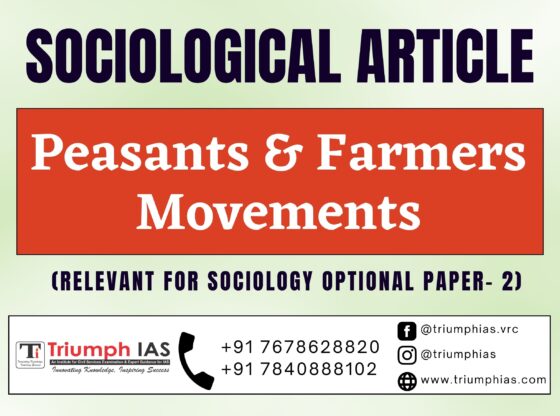Peasants & Farmers Movements
Relevant for sociology optional Paper- 2 (Unit- 13 : Social Changes in India)

Peasant and farmer movements in India have a long and rich history, dating back to the colonial era when British policies disrupted traditional agriculture and left many rural communities struggling to survive. Today, these movements continue to play a vital role in fighting for the rights and interests of small-scale farmers and peasants, who make up a significant portion of the country’s population.
One of the most significant peasant movements in India was the Champaran Satyagraha, which took place in 1917 in the state of Bihar. Led by Mahatma Gandhi, the movement aimed to support indigo farmers who were being forced to grow indigo instead of food crops by British landlords. This movement eventually led to the abolition of the oppressive indigo system and helped to establish Gandhi as a prominent leader of the Indian independence movement.
In the decades that followed, many other peasant and farmer movements emerged across India. These movements were often sparked by issues such as landlessness, exploitation by landlords, and low wages for agricultural laborers. One notable example was the Telangana peasant uprising of 1946-51, which aimed to establish a communist state in the region and saw widespread violence and repression by the Indian government.
More recently, the 2018 Kisan Long March in Maharashtra brought together tens of thousands of farmers from across the state to demand better prices for their crops, debt relief, and a waiver of electricity bills. This movement was seen as a powerful challenge to the ruling government’s pro-corporate policies and demonstrated the enduring strength of the Indian farmers’ movement.
Despite the many successes of these movements, however, they continue to face significant challenges. One of the main obstacles is the continued domination of agribusiness and corporate interests in the Indian agriculture sector. Large corporations often receive preferential treatment from the government, which can lead to the displacement of small-scale farmers and peasants from their land.
In addition, many farmers and peasants continue to struggle with poverty, debt, and lack of access to credit, which can make it difficult to sustain their livelihoods. This has been exacerbated in recent years by the effects of climate change, which have made it increasingly difficult for farmers to predict and adapt to changing weather patterns.
Despite these challenges, the resilience and determination of India’s peasant and farmer movements remain a source of hope and inspiration. These movements have shown time and time again that they are capable of mobilizing thousands of people to demand change and fighting for a more just and equitable society.
One of the key ways in which these movements have been able to achieve success is through the use of collective action and solidarity. By working together and pooling their resources, farmers and peasants have been able to exert pressure on governments and corporations to address their concerns and demands.
Another important factor in the success of these movements has been the use of nonviolent resistance and civil disobedience. By refusing to cooperate with oppressive systems and institutions, farmers and peasants have been able to create powerful symbolic gestures that have inspired others to join their cause and demand change.
Finally, the role of technology and social media cannot be ignored in the context of modern peasant and farmer movements. The use of social media platforms such as Twitter and Facebook has allowed farmers and peasants to share their stories and connect with others who are facing similar struggles, creating a global network of solidarity and support.
In conclusion, peasant and farmer movements in India have a long and complex history, characterized by struggle, resistance, and resilience. While these movements face many challenges, they continue to be a powerful force for change, demanding justice and equality for some of the most marginalized and vulnerable members of society. As India continues to grapple with the complexities of modernization and globalization, the voices and struggles of its farmers and peasants remain an essential component of its social and political fabric.
For more such free UPSC notes, Articles, News & Views Join our Telegram Channel. https://t.me/triumphias
Click the link below to see the details about the UPSC – Civils courses offered by Triumph IAS. https://triumphias.com/pages-all-courses.php


